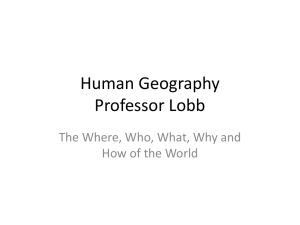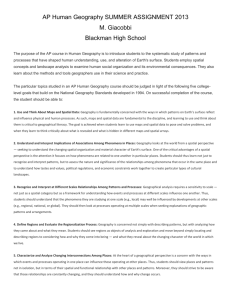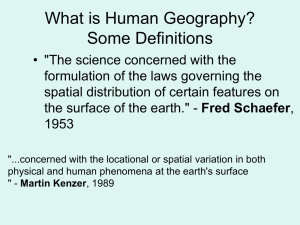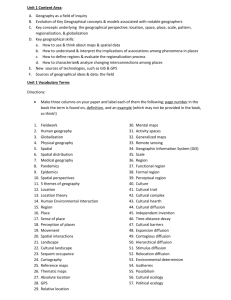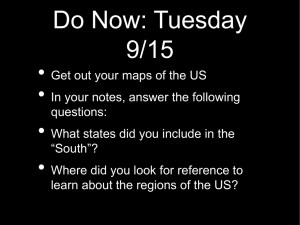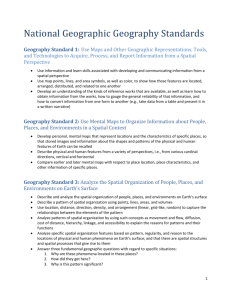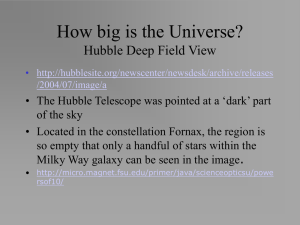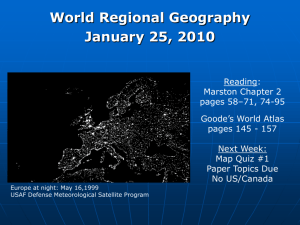Chapter 1 Study Guide Physical vs. Human Geography
advertisement
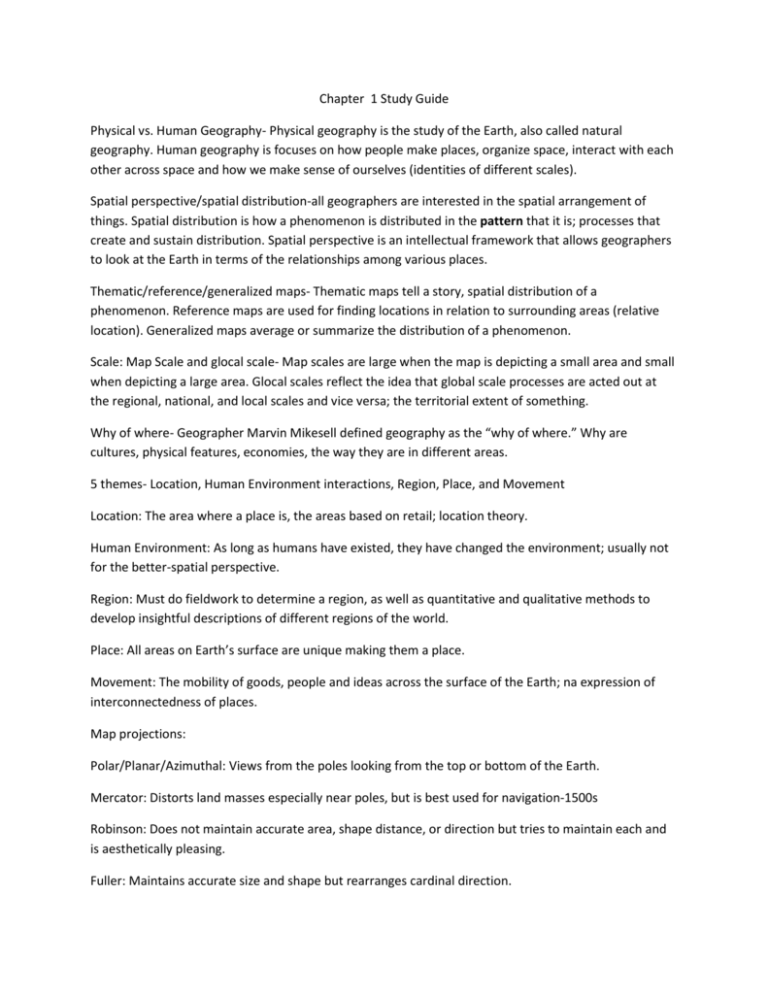
Chapter 1 Study Guide Physical vs. Human Geography- Physical geography is the study of the Earth, also called natural geography. Human geography is focuses on how people make places, organize space, interact with each other across space and how we make sense of ourselves (identities of different scales). Spatial perspective/spatial distribution-all geographers are interested in the spatial arrangement of things. Spatial distribution is how a phenomenon is distributed in the pattern that it is; processes that create and sustain distribution. Spatial perspective is an intellectual framework that allows geographers to look at the Earth in terms of the relationships among various places. Thematic/reference/generalized maps- Thematic maps tell a story, spatial distribution of a phenomenon. Reference maps are used for finding locations in relation to surrounding areas (relative location). Generalized maps average or summarize the distribution of a phenomenon. Scale: Map Scale and glocal scale- Map scales are large when the map is depicting a small area and small when depicting a large area. Glocal scales reflect the idea that global scale processes are acted out at the regional, national, and local scales and vice versa; the territorial extent of something. Why of where- Geographer Marvin Mikesell defined geography as the “why of where.” Why are cultures, physical features, economies, the way they are in different areas. 5 themes- Location, Human Environment interactions, Region, Place, and Movement Location: The area where a place is, the areas based on retail; location theory. Human Environment: As long as humans have existed, they have changed the environment; usually not for the better-spatial perspective. Region: Must do fieldwork to determine a region, as well as quantitative and qualitative methods to develop insightful descriptions of different regions of the world. Place: All areas on Earth’s surface are unique making them a place. Movement: The mobility of goods, people and ideas across the surface of the Earth; na expression of interconnectedness of places. Map projections: Polar/Planar/Azimuthal: Views from the poles looking from the top or bottom of the Earth. Mercator: Distorts land masses especially near poles, but is best used for navigation-1500s Robinson: Does not maintain accurate area, shape distance, or direction but tries to maintain each and is aesthetically pleasing. Fuller: Maintains accurate size and shape but rearranges cardinal direction. Peters: Centered on Africa to treat all regions equally, most accurate for position of land masses but cannot be used for navigation- 1974 Sense of Place: Infusing a place with meaning or emotion. Perception of place: Belief or understanding of what a place is like, often through books, movies, stories, or pictures. Used to make cognitive maps. Spatial interaction: Depends on the distances ( the measured physical space between two places), accessibility ( the ease of reaching one location from another) of places, and the transportation and communication connectivity ( the degree of linkage between locations in a network) among places. Cultural landscape: The visible imprint of human activity on the landscape- Carl Sauer 1925. Sequent occupance: Layers of imprint in a cultural landscape reflecting years of differing human activityDerwent Whittlesey 1929. Absolute location: Longitude and latitude; the exact geographic location associated with site: the physical and cultural characteristics of a place. Relative location: A place in relation to the places around it associated with situation: a place’s relationship to other places around it. GIS: A computer software program that allows geographers to map, analyze, and model spatial data. GPS: An integrated network of satellites that orbit Earth, broadcasting location information to handheld receivers on Earth’s surface; absolute location. Remote sensing: the process of capturing images of Earth’s surface from airborne platforms such as satellites or airplanes. Activity Spaces: Places we travel routinely in our rounds of daily activity. Mental Maps: In our minds to map our activity space and are more detailed when it comes to the activity space. Formal region: Has a shared cultural or physical trait, present throughout the region. Functional region: Have social and economic relationships that tie them together; defined by a set or social, political, or economic activities or interactions- places that interact and create connections. Perceptual regions: Exists in the minds of people. Intellectual constructs designed to help us understand the nature and distribution of phenomena in human geography; ideas in our minds based on accumulated knowledge of places and regions, that define an area of “sameness” or “connectedness.” Cultural diffusion: The process of dissemination, the spread of an idea or innovation from its hearth to other places (expansion and relocation) Expansion: the thing or process being spread remains in the area of origin as well as spreading to surrounding areas. Spreading outward from hearth. - Contagious: spreads to next available person. Stimulus: Promotes local experiment or change. Hierarchical: A pattern in which channel of diffusion is some segment of those who are susceptible to what is being diffused; spreads to most linked people or places first. Relocation: The actual movement of individuals who have already adopted the idea or innovation and who carry it to a new, possibly distant locale where they proceed to disseminate it. Environment determinism: The doctrine that human behavior, individually and collectively, is strongly affected by- even controlled or determined by- the physical environment; that climate is the critical factor in how humans behave. Possiblism: The argument that the natural environment merely serves to limit the range of choices available to a culture. The choices that a society makes depend on what its members need and on the technology available to them. Cultural ecology: an area of inquiry concerned with culture as a system of adaptation to and alteration of environment; the study of culture as an adaptation of environment.

